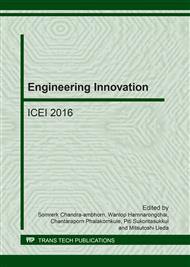[1]
A.M.M. Amir Moezzi, Michael B. Cortie, Zinc oxide particles, Synthesis, properties and applications, Chem. Eng. J. 185-186 (2012) 1-22.
DOI: 10.1016/j.cej.2012.01.076
Google Scholar
[2]
H.A. Oğuz Karvan, Investigation of CuO/mesoporous SBA-15 sorbents for hot gas desulfurization, Fuel. Process. Technol. 89 (2008) 908-915.
DOI: 10.1016/j.fuproc.2008.03.004
Google Scholar
[3]
Y. -C.C. Yi-Hsing Lin, Hsin Chu, The mechanism of coal gas desulfurization by iron oxide sorbents, Chemosphere. 121 (2015) 62-67.
DOI: 10.1016/j.chemosphere.2014.11.010
Google Scholar
[4]
J.S. Jakob Köchermann, Steffi Matthischke, Stefan Rönsch, Sorptive H2S removal by impregnated activated carbons for the production of SNG, Fuel. Process. Technol. 138 (2015) 37–41.
DOI: 10.1016/j.fuproc.2015.05.004
Google Scholar
[5]
H.M.G. Hector F. Garces, Luis J. Garces, Jennifer Hunt, Aimee Morey, Steven L. Suib, Low temperature H2S dry-desulfurization with zinc oxide, Micropor. Mesopor. Mater. 127 (2010) 190-197.
DOI: 10.1016/j.micromeso.2009.07.022
Google Scholar
[6]
B.T. Hongyun Yang, Novel-Doped Zinc Oxide Sorbents for Low Temperature Regenerable Desulfurization Applications, American Institute of Chemical Engineers Journal, 56 (2010) 2898-2904.
DOI: 10.1002/aic.12201
Google Scholar
[7]
T.S. Xiaohui Wang, Ji Yang, Ling Zhao, Jinping Jia, Low-temperature H2S removal from gas streams with SBA-15 supported ZnO nanoparticles, Chem. Eng. J. 142 (2008) 48-55.
DOI: 10.1016/j.cej.2007.11.013
Google Scholar
[8]
M.Z.S. Saeed Parhoodeh, Mansoor Farbod, Efficient absorption of H2S by aluminum doped zinc oxide nanoparticles, Mater. Letters. 78 (2012) 188-191.
DOI: 10.1016/j.matlet.2012.03.039
Google Scholar
[9]
J. -W.B. Suk-Hwan Kang, Hyung-Tae Kim, Ki-Won Jun, Soon-Yong Jeong, K.V.R. Chary, Effective Removal of Odorants in Gaseous Fuel for the Hydrogen Station Using Hydrodesulfurization and Adsorption, Energy & Fuels, 21 (2007) 3537–3540.
DOI: 10.1021/ef7002188
Google Scholar
[10]
M.F.G. Mariana Noelia Barroso, Julio Andrade Gamboa, M.C.A. Luis Alberto Arrua, Preparation and characterization of CuZnAl catalysts by citrate gel process, J. Phys. Chem. Solids. 67 (2006) 1583-1589.
DOI: 10.1016/j.jpcs.2006.01.114
Google Scholar
[11]
D.M. Wang, Breakthrough Behavior of H2S Removal with an Iron Oxide Based CG-4 Adsorbent in a Fixed-Bed Reactor,: submitted to the College of Graduate Studies and Research, Chemical Engineering, University of Saskatchewan (2008).
Google Scholar


